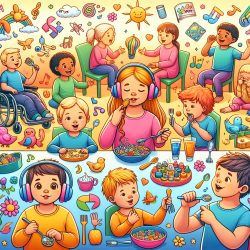Introduction
The intersection of sensory processing skills and feeding behaviors in children with cerebral palsy (CP) is a critical area of study, especially for those with cerebral visual impairment (CVI). Recent research published in the journal Children provides valuable insights into how these factors interplay and affect children aged 3–6 years. This blog aims to distill key findings from the study and suggest practical applications for practitioners working in speech language pathology and related fields.
Understanding the Research
The study in question evaluated sensory processing skills using the Sensory Profile (SP) and feeding behaviors using the Behavioral Pediatric Feeding Assessment Scale (BPFAS). The sample consisted of 90 mothers divided into three groups: children with CP and CVI, children with CP without CVI, and children with typical development (TD). The results showed significant differences in sensory processing and feeding behaviors across these groups.
Key findings include:
- Children with CP and CVI exhibited more significant sensory processing issues and feeding behavior problems than those with CP alone or TD.
- A strong correlation was found between sensory processing difficulties and feeding behavior problems, suggesting that sensory issues exacerbate feeding challenges.
- Feeding problems were prevalent in 65% of all groups, highlighting the need for targeted interventions.
Implications for Practitioners
For practitioners, these findings underscore the importance of a holistic approach when addressing feeding issues in children with CP. Here are some practical steps to consider:
- Comprehensive Assessment: Utilize tools like the SP and BPFAS to assess both sensory processing and feeding behaviors. This dual approach can help identify specific areas of need.
- Individualized Interventions: Develop tailored intervention plans that address both sensory and feeding challenges. Consider incorporating sensory integration techniques to improve sensory processing skills.
- Parental Involvement: Engage parents in the therapeutic process. Educating them about the relationship between sensory processing and feeding can empower them to support their child's development effectively.
- Multidisciplinary Collaboration: Work with occupational therapists, dietitians, and other specialists to create a comprehensive care plan that addresses all aspects of the child's needs.
Encouraging Further Research
While this study provides valuable insights, it also highlights the need for further research. Practitioners are encouraged to contribute to the body of knowledge by conducting studies that explore the efficacy of different intervention strategies. Sharing findings with the broader community can lead to improved outcomes for children with CP and CVI.
Conclusion
The relationship between sensory processing skills and feeding behaviors in children with CP, particularly those with CVI, is complex but crucial to understand. By applying the insights from this study, practitioners can enhance their therapeutic approaches and ultimately improve the quality of life for these children.
To read the original research paper, please follow this link: Relationship between Sensory Processing Skills and Feeding Behaviors in Children Aged 3–6 Years with Cerebral Palsy with Cerebral Visual Impairment.










